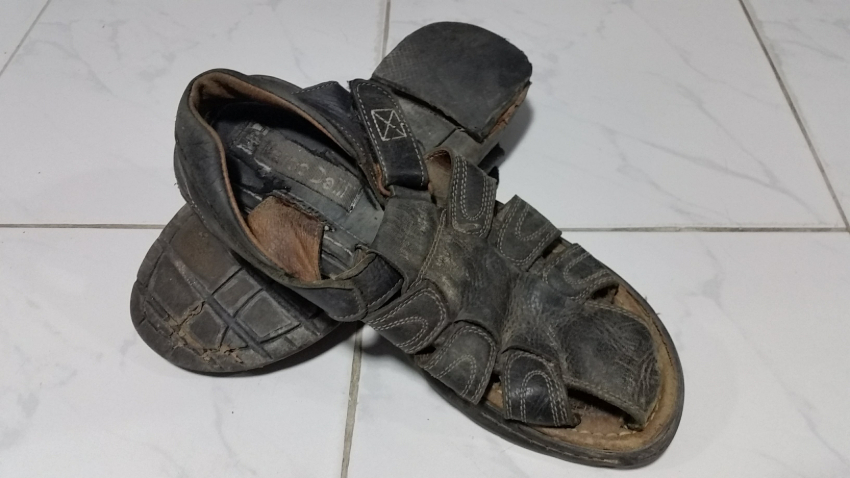While I still hold that sandals are the only footwear I’ll ever buy, I can’t say that cost savings will be the reason. I purchased my current pair of leather sandals in Mexico last year for about $15, much cheaper than it would cost me to buy a high quality pair of Western sandals. I have to be honest with you, though, I’ve probably spent as much money repairing them in the last year as I would have had I just bought a good pair of sandals to begin with. It’s been fun as the repairs get more and more simple, but cost effective, they’re not.
The first repair came about three months after I bought them. I do walk a lot, and they are my only pair of footwear. As happens with all my shoes, the back corners begin to wear due to my bowed legs. On my dad’s advice, I bought a pair of Eccos a few years back. I paid an obscene price for them, but the salesperson assured me they’d last 3 times longer than any other shoes I’d owned. That would have been true if I’d only owned my previous shoes for a month.
After 3 months, I began to see even greater wear on the heel than normal. I returned to the store, and they claimed it was caused by a material flaw and gave me a replacement pair on the spot. Three months later, I was back at the store again with the same problem. This time they gave me a different pair claiming they had harder soles. They didn’t, and after blowing through three pairs of Eccos in nine months, I gave up on them. It appears that no matter what footwear I own, I will always blow through the soles in about 3 months.
If you live in Portland, Oregon, it’ll come as no surprise that there are almost 20 cobblers in town, and despite that, I still had to wait two weeks for my sandals to be re-heeled. I dug out a pair of old shoes, which seemed constraining after walking in sandals for months, but in a couple weeks I was able to pick up my sandals with brand new Vibram heels for $45. Don’t think the irony is lost on me that I paid three times the price to fix my shoes than I’d originally paid to purchase them, but I am always guided my my principle of reducing waste.
The next time I needed the shoes re-heeled was just before my round the world trip. I’d put it off until too close to my departure date, and the cobbler said he couldn’t have them done in time. He told me I could just buy the heels and do it myself with some shoe goo and a sharp knife. It wouldn’t look pretty, but it could be done in the time I needed.
Two nights before my departure I set about learning how to cobble my own shoes. I managed to pry off the heel, sand the sole, apply the glue, attach and cut the new heels to fit. It was a bit sloppy but who looks at the soles of your shoes? I stuck them under my bed posts to apply pressure overnight.
I made the mistake of wearing them before the 24 hour curing period and that, combined with the rain, caused the heel to separate a bit, so I had to buy more glue to re-apply the heels that night. So far I was into these $15 shoes for about $85 dollars, about the cost of a high quality pair of sandals.
It reminded me of an argument I’d had with a friend in college. He said that I should spend more money on my bike purchase so that it would last longer. I told him that, while that may be true, for the same price as an expensive bike, I could buy seven cheap bikes, and I was sure that those cheap seven, collectively, would outlast the more expensive one individually.
My shoe repairs leave a little to be desired, and I wasn’t a month into travel before I needed another heel replacement. As luck would have it, Kuala Lumpur has cobblers scattered throughout the market district ready to make on the spot repairs. I had my doubts, knowing the glue required curing time, but I was too curious to resist watching how they’d do it.
The guy looked at my heel and then followed the same process I’d done in my living room a month before. The replacement heel was of inferior quality material, but the guy sitting on a tiny plastic stool on the sidewalk probably didn’t have access to the Vibram heel collection that my Portland cobbler did. The material he used was basically a scrap of foam rubber that he cut to size.
While making the repair, he showed me that the sole was beginning to split as well, so I nodded to him, and he repaired that too. Having not yet agreed to a price, I stopped him when he also began to repair the insole. He finished up what he’d done so far, even adding some shoe polish to the rubber. Though sweet, it seemed a fairly ineffective treatment to rubber.
I paid him the equivalent of $20 USD, which was likely too much, but it was my fault for not having asked the price in advance, and I figured some of that cost could be attributed to just having witnessed a shoe repair class.
Like an old car, my cheap pair of Mexican sandals was beginning bleed my wallet. I decided that when I return the states, I will call my college friend and tell him I’m going to buy the expensive bike this time.

